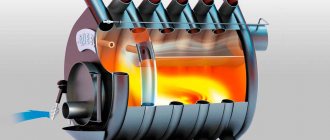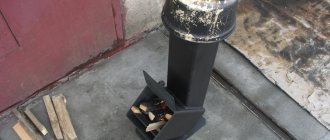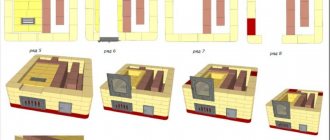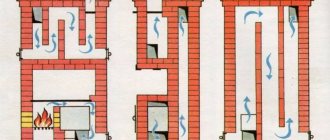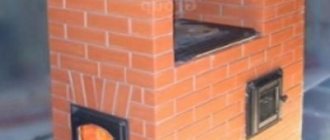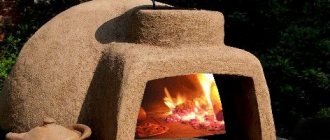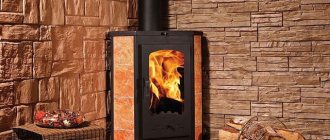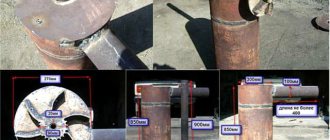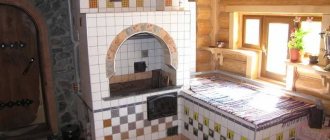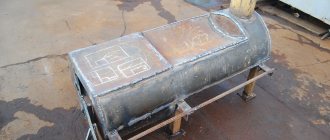Operating principle of a pyrolysis furnace
What is the operating principle of this stove? The processes occurring in it are unfamiliar to many, so it is necessary to study in more detail the principle of operation of a pyrolysis furnace.
A distinctive feature of a do-it-yourself pyrolysis furnace from a conventional one is that the fuel in it burns when there is a lack of oxygen. And this is surprising, because in conventional designs the fuel burns if there is a large amount of oxygen and this ensures the normal functioning of the entire heating system.
How does the pyrolysis process occur? When hydrocarbon fuels are burned, a process of oxidation and heat generation begins. Fuel under the influence of high temperature does not burn completely, releasing a large amount of various gases. The higher the temperature with a lack of oxygen, the more intense these gases begin to be released.
For example, if you burn wood fuel, gases such as acetic acid, acetone, and methyl alcohol will be released. Along with them, various resinous compounds and charcoal particles enter the chimney. These unburned residues can be re-burned because they are quite flammable. Gases that are not completely burned can be released when burning any fuel, such as natural organic matter or petroleum products. Different fuels have different combustion temperatures. Thus, petroleum products can burn at a temperature of 800-900 degrees, and firewood burns at 500 degrees.
Thus, the principle of operation of a do-it-yourself pyrolysis oven is to burn these gases. That is why such furnaces are also called gas generators. Pyrolysis is the process of decomposing fuel into its component parts when heated, followed by their combustion and release of heat.
Features of a long-burning stove
The first step is to understand what happens when wood burns. For a flame to appear, the temperature of the wood must be brought to approximately +150 degrees, using an external heating source. Usually, a piece of paper lit from an ordinary match is enough for this. After this, the process of slow charring of the material begins, which, after reaching +250 degrees, begins to decompose into simple chemical elements. The white smoke that appears when a flame is ignited includes gas and water vapor: they are emitted by heated wood. Ignition of the released gaseous components is observed when heating reaches +300 degrees: as a result of this, the thermochemical reaction is significantly accelerated.
The breakdown of organic matter into simple elements is called pyrolysis. Practice shows that during the combustion of wood, part of the energy potential inherent in it remains unused. This is reflected in a significant amount of waste remaining after the flame goes out. In pyrolysis furnaces, fuel is used much more efficiently, which is achieved by separate combustion of gases released during fuel combustion. At the same time, the rate of smoldering of the wood itself is very low, which helps to increase the operating time of the stove on one stack. The Bubafonya stove, which is a type of pyrolysis heater, guarantees almost complete combustion of all fuel.
Advantages and disadvantages of a pyrolysis furnace
This design has certain advantages over conventional ovens. These include:
- efficiency reaches 80%;
- fuel is consumed very economically;
- the ability to regulate the long-term combustion process;
- environmental friendliness. During operation, such a stove produces virtually no emissions of carcinogenic substances.
If a pyrolysis oven is made correctly, then its advantages are countless. For example, it has virtually no soot , which makes it easier to maintain cleanliness and spend a small amount of time cleaning the stove. And there are a lot of such small advantages.
However, the pyrolysis oven also has disadvantages:
- high price. It is more profitable to do it yourself;
- big sizes. If the room is not too large, it is better to use other heating structures;
- Such stoves are heated only with a certain type of fuel. Dry fuel (wood) is best suited because high humidity has a negative effect on the pyrolysis process;
- For its operation, a power supply is required, and a constant one at that. For best operation of the oven, it should be connected to an electrical network.
These are the main disadvantages of a pyrolysis oven. So you can safely operate such a stove if there is enough space for it, dry fuel is available and there is access to the electrical network.
Fuel
A pyrolysis furnace can use two types of solid fuel: wood or pellets. Its humidity can reach 50%. The fuel must be wet and dry - it must be dried in the open air, under a canopy. It must be taken into account that pellets in original packaging can increase their humidity by up to 30% if stored in an unheated room.
Fuel for pyrolysis furnaces
It is impossible not to mention pyrolysis oil. It is a product of a heating process of up to 800 degrees for a short period - up to 30 s. Essentially, pyrolysis oil is liquefied wood tar. It is characterized by a high calorific value, but contains a lot of sulfur, like household fuel, and corrodes metals. It is used on an industrial scale.
Pyrolysis boiler manufacturing technology
To make a powerful boiler, you need to be able to handle an angle grinder and a welding machine, as well as understand the drawings. If you independently manufacture a boiler with a power above 25 kW, you must do everything according to the drawing , otherwise the boiler will not meet safety requirements.
The walls of the boiler should be made of heat-resistant steel, only this will guarantee that it will last for quite a long time. If such steel cannot be found, you can use ordinary steel, only in this case the internal chambers of the boiler are lined with fireclay bricks.
Boiler manufacturing stages.
- The boiler body is made of sheet steel. Using a grinder, boiler parts are cut out of a sheet of metal, holes are made in the walls for the ash pan door and loading door, as well as for pipes and a smoke exhauster. The most important thing is to adhere to the dimensions indicated in the drawing. Using a welding machine, the parts are connected, after which the seams are cleaned of scale and ground.
- Then the pipes are welded so that there are no gaps between the seams. A pipe of the required diameter is taken and a protective heat exchanger is installed on the rear wall of the boiler. After that, they check whether the heat exchanger is leaking due to increased pressure from the compressor, and only then install the rear wall of the chamber, made of heat-resistant steel.
- Then they begin to install a partition that separates the gasification and gas combustion chambers, installing a cast iron grate. An air duct with a damper is made at the top of the gasification chamber. An air duct is also made at the bottom of the chamber and at the same time the bottom and sides are lined with fireclay bricks.
- The boiler doors are made of heat-resistant steel, and for maximum tightness they are reinforced with metal corners.
- The boiler should be installed in a non-residential area, connecting the chimney. Then a water circuit is connected to it and a smoke pump is installed.
Manufacturing technology of a pyrolysis furnace
This boiler is very powerful and therefore suitable for a large house. To keep your garage or country house warm, you can build a pyrolysis oven with your own hands. It is also made from a sheet of metal, but its manufacturing technique is much simpler.
If the gas combustion chamber is located above the gasification chamber, creating natural draft, then there is no need to use a smoke exhauster.
The stove is not connected to the heating system.
Such a furnace is not automated and therefore requires constant monitoring and adjustment of the combustion mode.
Pyrolysis process
Furnaces for efficient combustion of organic fuel decomposition products may differ from each other in design and materials of manufacture. First of all, they are distinguished by designs that use the principle of upper and lower combustion. Devices with afterburning chambers at the bottom clearly require additional pumping equipment. While some manufacturers offer devices that work using natural draft. Usually, they are called slow burning stoves.
Ignition of volatile compounds produced during the decomposition of organic matter occurs through the flames of the main combustion chamber and a smoldering mode is possible. There are also extraordinary private solutions in the form of brick structures. It is difficult to talk about the rationality and energy efficiency of such developments due to the lack of accurate and objective measurements. In other cases, alloy structural steel of different thicknesses is most often used.
How to make a pyrolysis oven with your own hands?
The technology for making a pyrolysis furnace with your own hands is carried out in the following sequence.
- Take the furnace body, which has holes for the firebox door and ash pan door, and weld it. It must be made of heat-resistant steel. A combustion chamber is installed directly and separated from it by a cast-iron grate. The flow of air into the firebox is regulated using the ash pan door.
- A gas combustion chamber is placed above the firebox, separating them with a heat-resistant steel plate. A channel is made in the chamber to provide air supply.
- The metal doors of the firebox and ash pan are reinforced with a corner.
- Inside, both chambers are lined with fireclay bricks, which will protect them from rapid burning and improve heat distribution. If the stove is installed in a living room, then it can also be covered on the outside so that you do not accidentally get burned on it.
- A damper is installed in the chimney to regulate draft. The chimney is made of an insulated pipe, which increases its safety. If the pipe is not insulated, in the event of sudden temperature changes, condensation accumulates on its inner surface, which can destroy the metal.
Video
Stove heating in Ukraine, as they say, is experiencing a rebirth. The reasons for this phenomenon are clear without any explanation.
That is why Kharkov innovator Oleg Petrik proposed using pulverized-coal thermal power plant technologies to increase the efficiency of home stoves, and for this it is not at all necessary to have the skills of an experienced mechanic. How can you increase the efficiency of a coal (wood-burning) stove or solid fuel boiler without the use of additional energy resources. The principle of operation of the technology is quite simple : water from the reservoir (steam generator) turns into steam at a high temperature (400 - 500 C) and is supplied directly to the flame, acting as a kind of combustion catalyst that increases the performance of the heating installation. To create an innovation system, you will need: a steam generator, which is made from improvised means ( A canister or pan is suitable, preferably made of stainless steel; even an old moonshine still can be used). A nipple from a car tire is cut into the container. You will also need about half a meter of oxygen hose and about one and a half meters of tube, preferably made of thin-walled stainless steel with an internal diameter of 8 mm, from which the superheater is made.
Installation location of the pyrolysis furnace
Install the pyrolysis oven indoors, observing safety precautions to prevent fire. Do not install it near flammable objects, under shelves, or in easily blown places. There should be free space around the stove on all sides with a distance of half a meter. It’s good if there is a container with sand or a fire extinguisher hanging nearby.
In order for a do-it-yourself pyrolysis furnace to work for a long time, it is necessary to remove coke and carbon deposits from the lower part in a timely manner . If fuel oil or petroleum oils are used as fuel, care must be taken to ensure that no water gets into it. If this happens, the oven will start to “shoot”, throwing out a large number of sparks, and this can lead to a fire.
Therefore, subject to safety precautions and proper operation, such a stove can last a very long time.
Negative effects of reduced loads
In addition, during calculations, one should take into account the negative impact on the entire fuel system of working with a reduced load.
- With excess power, increased moisture condensation occurs on heat exchangers and chimney surfaces, in slow modes. Therefore, the installation must be selected in such a way that the vast majority of the time, combustion takes place with the most efficient performance and coolant temperature, up to 80 - 90 ° C. Using such a unit irregularly or for periodic heating at the dacha will not be at all rational.
- The type of fuel used has no less influence in the calculations. The caloric content of which, like its humidity, significantly affects the power received and creates a certain delta of up to 25 -30%.
- When using coal, especially heat-loaded surfaces of the secondary afterburning chamber must be protected by a lining, usually fireclay brick.
- Cast iron should be used as the main material due to its resistance to fading and deformation. But, as you know, working with it in artisanal conditions is almost impossible, so making a stove of such parameters with your own hands is out of the question.
- For home craftsmen, the main material is structural steel, preferably having heat-resistant characteristics, otherwise the lack of heat resistance will have to be compensated by the thickness of the walls.

